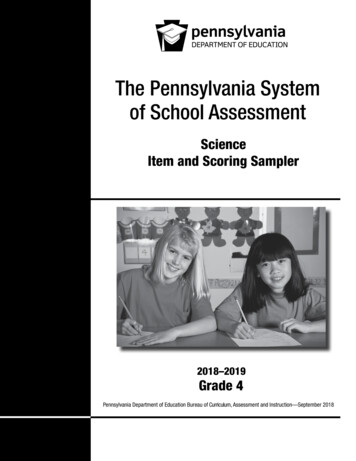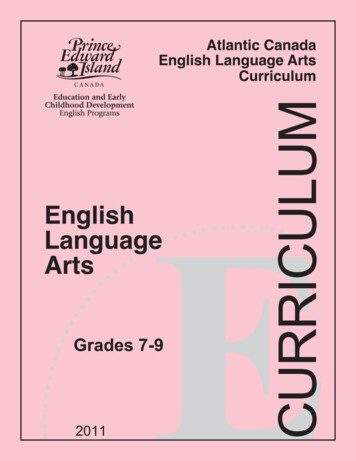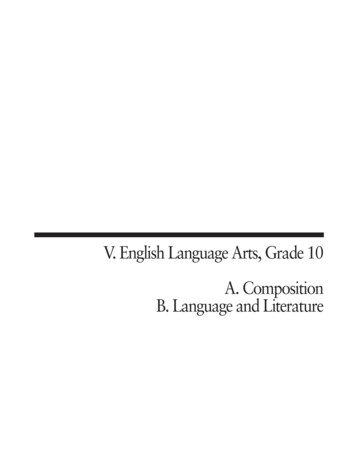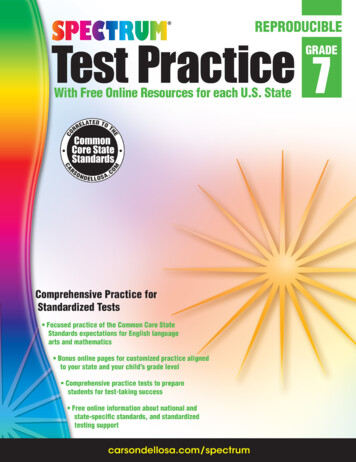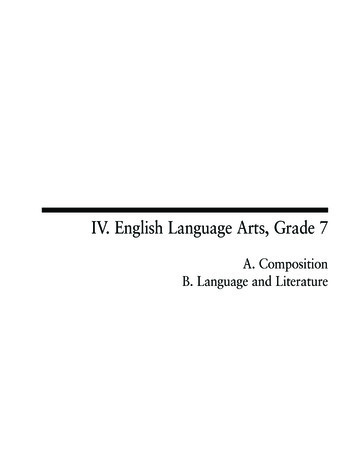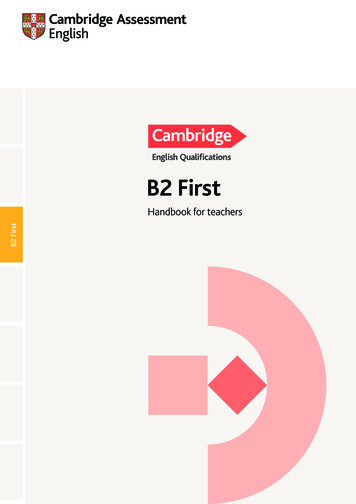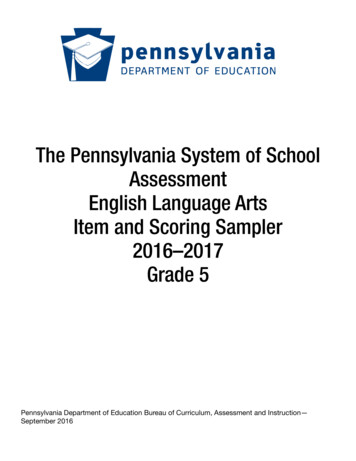
Transcription
The Pennsylvania System of SchoolAssessmentEnglish Language ArtsItem and Scoring Sampler2016–2017Grade 5Pennsylvania Department of Education Bureau of Curriculum, Assessment and Instruction—September 2016
TABLE OF CONTENTSINFORMATION ABOUT ENGLISH LANGUAGE ARTSIntroduction . . . . . . . . . . . . . . . . . . . . . . . . . . . . . . . . . . . . . . . . . . . . . . . . . . . . . . . . . . . . . . . . . 1General Introduction. . . . . . . . . . . . . . . . . . . . . . . . . . . . . . . . . . . . . . . . . . . . . . . . . . . . . . . 1Pennsylvania Core Standards (PCS). . . . . . . . . . . . . . . . . . . . . . . . . . . . . . . . . . . . . . . . . . . 1What Is Included. . . . . . . . . . . . . . . . . . . . . . . . . . . . . . . . . . . . . . . . . . . . . . . . . . . . . . . . . . 1Purpose and Uses. . . . . . . . . . . . . . . . . . . . . . . . . . . . . . . . . . . . . . . . . . . . . . . . . . . . . . . . . 1Item Format and Scoring Guidelines . . . . . . . . . . . . . . . . . . . . . . . . . . . . . . . . . . . . . . . . . . 2English Language Arts Grade 5 . . . . . . . . . . . . . . . . . . . . . . . . . . . . . . . . . . . . . . . . . . . . . . 3English Language Arts Test Directions for Reading Passages and Questions . . . . . . . . . . . . . . 4PSSA ENGLISH LANGUAGE ARTS GRADE 5Passage 1. . . . . . . . . . . . . . . . . . . . . . . . . . . . . . . . . . . . . . . . . . . . . . . . . . . . . . . . . . . . . . . . . . . 6Multiple-Choice Questions. . . . . . . . . . . . . . . . . . . . . . . . . . . . . . . . . . . . . . . . . . . . . . . . . . 9Evidence-Based Selected-Response Question. . . . . . . . . . . . . . . . . . . . . . . . . . . . . . . . . 15Passage 2. . . . . . . . . . . . . . . . . . . . . . . . . . . . . . . . . . . . . . . . . . . . . . . . . . . . . . . . . . . . . . . . . . 16Multiple-Choice Questions. . . . . . . . . . . . . . . . . . . . . . . . . . . . . . . . . . . . . . . . . . . . . . . . . 19Evidence-Based Selected-Response Questions . . . . . . . . . . . . . . . . . . . . . . . . . . . . . . . . 24Passage 3. . . . . . . . . . . . . . . . . . . . . . . . . . . . . . . . . . . . . . . . . . . . . . . . . . . . . . . . . . . . . . . . . . 26Text-Dependent Analysis Question. . . . . . . . . . . . . . . . . . . . . . . . . . . . . . . . . . . . . . . . . . . 29Text-Dependent Analysis Scoring Guideline. . . . . . . . . . . . . . . . . . . . . . . . . . . . . . . . . . . . 33English Language Arts Test Directions for Language Questions and Writing Prompt. . . . . . . . 45Standalone Multiple-Choice Questions. . . . . . . . . . . . . . . . . . . . . . . . . . . . . . . . . . . . . . . . . . . 46Writer’s Checklist and Opinion Writing Prompt . . . . . . . . . . . . . . . . . . . . . . . . . . . . . . . . . . . . . 50Opinion Scoring Guideline . . . . . . . . . . . . . . . . . . . . . . . . . . . . . . . . . . . . . . . . . . . . . . . . . 54English Language Arts—Sample Item Summary Data. . . . . . . . . . . . . . . . . . . . . . . . . . . . . . . . 61ACKNOWLEDGEMENTS. . . . . . . . . . . . . . . . . . . . . . . . . . . . . . . . . . . . . . . . . . . . . . . . . . . . . . . . . . 63PSSA Grade 5 English Language Arts Item and Scoring Sampler—September 2016ii
INFORMATION ABOUT ENGLISH LANGUAGE ARTSINTRODUCTIONGeneral IntroductionThe Pennsylvania Department of Education provides districts and schools with tools to assist in deliveringfocused instructional programs aligned with the Pennsylvania Core Standards (PCS). These tools includeAcademic Standards, Assessment Anchor documents, assessment handbooks, and content-based item andscoring samplers. This Item and Scoring Sampler is a useful tool for Pennsylvania educators in preparing localinstructional programs. It can also be useful in preparing students for the statewide assessment.Pennsylvania Core Standards (PCS)This sampler contains examples of test questions that are aligned to the new Pennsylvania Core Standardsbased 2016 PSSA Assessment Anchors and Eligible Content. The Mathematics, Reading, and Writing PSSAtransitioned to PCS-based operational Mathematics and English Language Arts assessments starting with thespring 2015 PSSA administration.The 2016 PCS-aligned Assessment Anchor and Eligible Content documents are posted on this portal:¾¾www.education.pa.gov [Hover over “K–12,” select “Assessment and Accountability,” and select“Pennsylvania System of School Assessment (PSSA).” Then select “Assessment Anchors” fromthe “Other Materials” list on the right side of the screen.]What Is IncludedThis sampler contains stimulus reading passages with test questions, standalone questions, and modespecific prompts that have been written to align to the Assessment Anchors that are based on thePennsylvania Core Standards (PCS). The passages represent some of the genres approved by PDE to appearon an operational, PCS-based PSSA. The test questions provide an idea of the types of items that mayappear on an operational, PCS-based PSSA. Each sample test question has been through a rigorous reviewprocess to ensure alignment with the Assessment Anchors.Purpose and UsesThe items in this sampler may be used as examples for creating assessment items at the classroom level,and they may also be copied and used as part of a local instructional program.1 Classroom teachers may findit beneficial to have students respond to the open-ended items in this sampler. Educators can then use thesampler as a guide to score the responses either independently or together with colleagues within a school ordistrict.1The permission to copy and/or use these materials does not extend to commercial purposes.PSSA Grade 5 English Language Arts Item and Scoring Sampler—September 20161
INFORMATION ABOUT ENGLISH LANGUAGE ARTSItem Format and Scoring GuidelinesThe PCS-based PSSA has multiple types of test questions. For grade 5, the types of test questions areMultiple-Choice questions (MC), Evidence-Based Selected-Response questions (EBSR), Text-DependentAnalysis Questions (TDA), and mode-specific Writing Prompts (WP).Multiple Choice: Each of this type of test question has four answer choices. Some MC test questions arebased on a stimulus reading passage, while other MC test questions are independent of a passage. Eachcorrect response to an MC test question is worth one point.Evidence-Based Selected Response: Each two-part EBSR question is designed to elicit an evidence-basedresponse from a student who has read either a Literature or Informational Text passage. In Part One, which issimilar to a multiple-choice question, the student analyzes a passage and chooses the best answer from fouranswer choices. In Part Two, the student utilizes evidence from the passage to select one or more answersbased on his/her response to Part One. Part Two is different from a multiple-choice question in that there maybe more than four answer options and more than one correct answer. Each EBSR test question is worth eithertwo or three points, and students can receive partial credit for providing a correct response to Part One or forproviding one or more correct responses in Part Two.Text-Dependent Analysis Question: Unlike a writing prompt, the TDA question is a text-dependent analysisquestion based on a passage or passage set that each student has read during the test event. There arethree response pages in the paper-and-pencil format and up to 5,000 characters in the online format. BothLiterature and Informational Texts are addressed through this item type. Students must draw on basic writingskills while inferring and synthesizing information from the passage in order to develop a comprehensive,holistic essay response. The demand required of a student’s reading and writing skills in response to a TDAcoincides with the similar demands required for a student to be college and career ready. The TDA responseis scored using a holistic scoring guideline on a 1–4-point scale.Writing Prompt: Each of this type of test question includes an extended response space in which the studentcomposes an answer based on a provided prompt. There are two response pages in the paper-and-pencilformat and up to 3,000 characters in the online format. A writing prompt is based on a specific mode ofwriting and may ask the student to write an opinion essay, an informative/explanatory essay, or a narrativeessay. Each writing prompt is scored on a 1–4-point scale using a holistic, mode-specific scoring guideline. Inthis sampler, examples of student responses representing each score point can be combined with the modespecific scoring guideline to form a practical scoring guide.Testing Time and Mode of Testing Delivery for the PCS-Based PSSAThe PSSA is delivered in traditional paper-and-pencil format as well as in an online format. The estimatedtime to respond to a test question is the same for both methods of test delivery. The following table shows theestimated response time for each item type.During an official test administration, students are given as much additional time as is necessary to completethe test questions.English Language Arts Item Type:MC:EBSR:Estimated Response Time (minutes) 1.5Estimated Response Time (minutes) 3 to 5TDA: Estimated Response Time (minutes) 45WP:Estimated Response Time (minutes) 30PSSA Grade 5 English Language Arts Item and Scoring Sampler—September 20162
INFORMATION ABOUT ENGLISH LANGUAGE ARTSEnglish Language Arts Grade 5This English Language Arts Sampler is composed of 3 passages, 11 passage-based multiple-choicequestions, 3 evidence-based selected-response questions, a text-dependent analysis question, 4 standalonemultiple-choice questions, and a mode-specific writing prompt.There are three passages in this booklet. The first passage is followed by a set of passage-based multiplechoice questions and an evidence-based selected-response question. The second passage is followed bya set of passage-based multiple-choice questions and 2 evidence-based selected-response questions. Thethird passage is followed by a text-dependent analysis question. This booklet also contains 4 standalonemultiple-choice questions and a mode-specific writing prompt.Each question is accompanied by a chart that contains the Assessment Anchor and Eligible Content coding,answer key(s), depth of knowledge, and testing data. Each question is followed by a brief analysis orrationale. The text-dependent analysis question and the writing prompt are displayed with the item-specificscoring guidelines and examples of student responses with scores and annotations at each scoring level.The PCS-based PSSA may be administered in paper-and-pencil format or online. As a result, thissampler includes samples of text-dependent analysis question responses and mode-specific writingprompt responses in both formats.PSSA Grade 5 English Language Arts Item and Scoring Sampler—September 20163
INFORMATION ABOUT ENGLISH LANGUAGE ARTSENGLISH LANGUAGE ARTS TEST DIRECTIONS FOR READING PASSAGES ANDQUESTIONSDirections:On the following pages are the Language questions and the Writing prompt.Directions for Multiple-Choice Questions:Some questions will ask you to select an answer from among four choices.For the multiple-choice questions:First, read the passage carefully.Read each question and choose the best answer.Only one of the answers provided is correct.You may look back at the passage to help you answer the question.Record your choice in the answer booklet.Directions for Selected-Response Questions:Some questions will have two parts and will ask you to select one or more answers in each part.For the selected-response questions:Read Part One of the question and choose the best answer.You may look back at the passage to help you answer Part One of the question.Record your answer to Part One in the answer booklet.Only one of the answers provided in Part One is correct.Then, read Part Two of the question and choose the best answer or answers based on your answerto Part One. If Part Two tells you to select two answers, be sure to select two answers.You may look back at the passage to help you answer Part Two of the question.Record your answer or answers to Part Two in the answer booklet.Directions for Text-Dependent Analysis (TDA) Questions:The English Language Arts TDA question will ask you to analyze the passage and use evidence fromthe passage to write an essay.For the TDA Essay:Be sure to read the passage and TDA question carefully.PSSA Grade 5 English Language Arts Item and Scoring Sampler—September 20164
INFORMATION ABOUT ENGLISH LANGUAGE ARTSReview the Writer’s Checklist to help you plan and organize your response.You may look back at the passage to help you write your essay.Write your essay in the appropriate space in the answer booklet. If you use scratch paper to write arough-draft essay, be sure to transfer your final essay to the answer booklet.Be sure to check that your essay contains evidence from the passage to support your response.Be sure to check your essay for errors in capitalization, spelling, sentence formation, punctuation,and word choice.PSSA Grade 5 English Language Arts Item and Scoring Sampler—September 20165
EGRADE55PASSAGE 1Read the following passage about Louis Braille. Then answer questions 1–7.Louis Braille1809–1852The instructor tapped on his desk, calling the reading class to order. But this was no ordinary readingclass. The embossed books used by the French Royal Institute for Blind Youth in 1819 were sospecial that the school owned just fourteen of them. This was ten-year-old Louis’s first day in classand he was thrilled: he would finally be able to read on his own!Embossed books for the blind had been invented 30 years earlier. To make them, large letters werepressed into thick sheets of waxed paper, leaving impressions. Then, when the page was turnedover, the letters could be read by tracing their outlines with a finger. The only problem was, eachpage could hold just a few sentences, so the books were big and fat. You couldn’t even hold one,but had to prop it up on an easel.Still . . . it was reading, and after the seven years of darkness since he’d lost his sight, Louis wasexcited. But his excitement soon turned to disappointment. Louis found that tracing each letter withhis finger took so long that by the time he got to the end of a sentence, he couldn’t remember whatit said at the beginning. Even if he could remember what he was reading, what good did it do? In allof France, there were just a handful of embossed books. They were too expensive to print and toobig to store.There must be a better way, Louis thought. For years the problem occupied his mind, and ultimatelyevolved into the greatest gift to blind people that has ever been invented: a reading system knownsimply as braille, for the boy who invented it.Louis Braille lost his sight at age three, when he accidentally poked his eye with a tool in his father’sharness-making shop in Coupvray, a small village 25 miles from Paris. The eye became infected, andwhen little Louis rubbed it, he accidentally spread the infection to the other eye as well. Within weeksof the accident, he was totally blind in both eyes. His father made him a cane that allowed him toexplore his physical surroundings, but the cane could only take him so far into the world.Luckily, the village priest in Coupvray saw Louis for what he was: a normal boy who happened tobe blind. Fr. Jacques Palluy taught him and convinced the schoolmaster to accept Louis as a pupil.As if to make up for his lack of vision, Louis’s memory was phenomenal, and he learned rapidly. Sorapidly that Fr. Jacques was able to get him into the Royal Institute for Blind Youth in Paris.At the school Louis read his first books and acquired skills that would allow him to support himself.When he was thirteen, the institute had an important visitor, a man who would change Louis’s life.Charles Barbier was a retired captain in the French army who had invented a military code based ondots and dashes punched with a stylus (a sharply pointed, pen-like tool) into strips of cardboard. Thecode allowed field commanders to silently give orders like “Advance” or “Withdraw” at night. Whenit occurred to Barbier that blind people might find it useful, he expanded his code so each word wasbroken into sounds and each sound was a different combination of dots and dashes. He called it“sonography” or “sound-writing.”PSSA Grade 5 English Language Arts Item and Scoring Sampler—September 20166
PSSA ENGLISH LANGUAGE ARTS GRADE 5Sonography looked complicated, but the school’s director agreed to try it. Louis became asonography expert, but the more he learned about it, the more problems he found: since thesymbols represented sounds, there was no way to show spelling, punctuation, or numbers. Andmany of the symbols were too big to read with the single touch of a finger. Sonography was so hardto use, many blind students gave up.Louis didn’t give up, but began experimenting with sonography. From age thirteen to fifteen, hisdays were filled with classes and friends, but at night and on weekends he created patterns of dots,trying to find an easier system. Some nights, Louis lost track of time; as he sat on his bed punchingdots, the rumbling of wagons outside told him that morning had come. His passion took a toll on hishealth, and he developed tuberculosis.Then one night, as his classmates snored away, a brainwave hit Louis: the sounds were the problem.He had been stuck trying to work within Barbier’s system when it was the system itself that waswrong. Instead of representing sounds, Louis created symbols that stood for the letters of thealphabet. Just like the alphabet sighted people use. His code was made up of six dots like this:123456This code unit, called the “braille cell,” has space for six dots: two across and three down. Foreach letter of the alphabet, mark of punctuation, symbol, and number, Louis worked out a differentarrangement of dots. Here’s how his first name looks in braille:LOUISEvery letter and symbol could fit within the space of a fingertip. When he demonstrated his inventionfor the school’s director, Dr. Pignier, he asked him to read aloud a paragraph from any book: “Readslowly and distinctly, as if you were reading to a sighted friend who was writing down your words.”As Pignier read, Louis punched holes with his stylus onto a sheet of paper. It was so easy to dothat he told Dr. Pignier, “You can read faster.” Pignier finished reading and Louis finished “writing”at almost the same time. Then, as the amazed director watched, Louis turned the paper over andread, with his fingertips, the raised bumps his stylus had left—every word Dr. Pignier had dictated.The man was overwhelmed with emotion. He knew what this meant: a fifteen-year-old boy had justswitched on the light of learning for blind people forevermore.During the next few years, Louis improved and added to his system. At twenty, his system perfected,he wrote a book explaining it, called Methods of Writing Words, Music, and Plain Song by Means ofDots, for Use by the Blind and Arranged by Them. The braille system solved the main problems ofthe earlier embossed books. Since braille letters could fit under a person’s fingertip, it was possibleto read much faster. Braille letters took up about the same space as printed letters, so the booksweren’t so huge and expensive to produce. And best of all, because braille was like the regularalphabet that sighted people used, it was easy to learn.Despite Dr. Pignier’s enthusiasm, government officials were slow to change. They didn’t want to giveup their old embossed letter system and asked, “Why should blind people learn a different alphabetthan the rest of us?” Obviously, they never had to read their embossed books! When Louis’s schoolgot a new director, even he refused to use braille. But so many students were smuggling stylusesinto the school and teaching each other braille, the new director had to give in.Louis stayed at the institute his entire life, teaching and playing music. When tuberculosis overtookPSSA Grade 5 English Language Arts Item and Scoring Sampler—September 20167
PSSA ENGLISH LANGUAGE ARTS GRADE 5him, at forty-three, his last words were, “I am convinced that my mission on earth is finished.”At the school for the blind, Louis also learned to play musical instruments. He was so good that forthe rest of his life he earned a living playing music in Paris churches.PSSA Grade 5 English Language Arts Item and Scoring Sampler—September 20168
PSSA ENGLISH LANGUAGE ARTS GRADE 5Multiple-Choice Questions1. Read the sentence from the passage.“Then one night, as his classmates snored away, a brainwave hit Louis: the sounds were theproblem.”What does the phrase “a brainwave hit Louis” mean?A. Louis was hit by a large wave of water.B. Louis became soaked in a sudden thunderstorm.C. Louis experienced a very deep sleep.D. Louis came up with a new idea.Item InformationAlignmentAnswer KeyDepth of Knowledgep-value Ap-value Bp-value Cp-value DOption AnnotationsB-V.4.1.2D22%2%4%92% (correct answer)The student is asked to interpret figurative language used in a phrase from thepassage. Option D is the correct answer since it fits the context of the passage.The passage indicates that while Louis’s classmates were sleeping he figuredout why his other ideas had not succeeded. Options A, B, and C are incorrectsince the evidence in the passage does not support these ideas.PSSA Grade 5 English Language Arts Item and Scoring Sampler—September 20169
PSSA ENGLISH LANGUAGE ARTS GRADE 52. The meaning of the root “-graph” helps the reader know that the word “paragraph” refers tosomething that isA. in a pattern.B. read aloud.C. in writing.D. sounded out.Item InformationAlignmentAnswer KeyDepth of Knowledgep-value Ap-value Bp-value Cp-value DOption AnnotationsB-V.4.1.1C219%7%68% (correct answer)5%The student is asked to use the root “-graph” to identify the meaning of theword “paragraph.” Option C is the correct answer because the root word“-graph” means “writing.” Options A, B, and D are not related to the given rootword.PSSA Grade 5 English Language Arts Item and Scoring Sampler—September 201610
PSSA ENGLISH LANGUAGE ARTS GRADE 53. Read the sentence from the passage.“He knew what this meant: a fifteen-year-old boy had just switched on the light of learning forblind people forevermore.”What does the metaphor “switched on the light of learning” mean?A. A young man designed a tool that would make a great impact for people who were blind.B. Dr. Pignier feels learning is very important for children whether they are at home or at school.C. A fifteen-year-old boy invented a special light to help others see clearly while they read.D. Dr. Pignier feels students who are blind should start school when they are fifteen years old.Item InformationAlignmentAnswer KeyDepth of Knowledgep-value Ap-value Bp-value Cp-value DOption AnnotationsB-V.4.1.2A382% (correct answer)7%8%3%The student is asked to infer the meaning of a given metaphor. Option A isthe correct answer since Louis created a tool that would have a long-lastingimpact for blind people. Options B, C, and D are not correct since theyare misinterpretations of the given metaphor and are not supported by thepassage.PSSA Grade 5 English Language Arts Item and Scoring Sampler—September 201611
PSSA ENGLISH LANGUAGE ARTS GRADE 54. Which detail from the passage supports the point that young people who attended the RoyalInstitute recognized the value of the new system for reading before others did?A. “Since braille letters could fit under a person’s fingertip . . .”B. “ . . .so the books weren’t so huge and expensive to produce.”C. “They didn’t want to give up their old embossed letter system . . .”D. “. . . many students were smuggling styluses into the school . . .”Item InformationAlignmentAnswer KeyDepth of Knowledgep-value Ap-value Bp-value Cp-value DOption AnnotationsB-C.3.1.1D322%15%20%43% (correct answer)The student is asked to identify a detail from the passage that best supportsthe author’s point that young people at the Royal Institute recognized the valueof Braille’s system for reading before others did. Option D is the correct answer.The fact that students brought styluses to school, even when the director of theschool refused to use braille, supports the idea that young people recognizedthe system’s value. Options A, B, and C do not relate to the author’s point.PSSA Grade 5 English Language Arts Item and Scoring Sampler—September 201612
PSSA ENGLISH LANGUAGE ARTS GRADE 55. How does the information in the text box relate to the information in the passage?A. by explaining what else Louis accomplished in his lifeB. by identifying the type of instruments Louis was able to playC. by explaining why Louis wanted to attend the school for the blindD. by identifying how Louis earned a living to pay for his school tuitionItem InformationAlignmentAnswer KeyDepth of Knowledgep-value Ap-value Bp-value Cp-value DOption AnnotationsB-C.3.1.3A273% (correct answer)6%12%8%The student is asked to determine how information in thetext box relates to information in the passage. Option A is the correct answer.The text box provides information about Louis Braille’s other accomplishments,which included earning “a living playing music.” Options B, C, and D are notideas that relate the information in the text box to the passage.PSSA Grade 5 English Language Arts Item and Scoring Sampler—September 201613
PSSA ENGLISH LANGUAGE ARTS GRADE 56. What is the best summary of the passage?A. While living at a school for the blind, Louis found a new way for blind people to read. Louisstudied the new method, but he found problems in it. He worked day and night to fix theproblems and became ill because he worked too much.B. Although books for the blind had already been invented, Louis was not satisfied. He learnedabout sonography and worked to improve it. Eventually, Louis developed a system that wouldchange reading for the blind forever.C. Louis Braille did not like the embossed books for the blind. They were big and had to bepropped up on an easel. Louis knew that someday there would be a better way of writing for theblind.D. Louis Braille lost his eyesight when he accidentally poked his eye with a tool and then spreadthe infection. He was only three years old. With the help of the village priest, Louis was sent to aschool and learned to read.Item InformationAlignmentAnswer KeyDepth of Knowledgep-value Ap-value Bp-value Cp-value DOption AnnotationsB-K.1.1.2B316%68% (correct answer)6%9%The student is asked to identify the best summary of the passage. Option B isthe correct answer since it includes the key ideas of the passage. Options A,C, and D are incorrect because they do not include all of the key ideas of thepassage.PSSA Grade 5 English Language Arts Item and Scoring Sampler—September 201614
PSSA ENGLISH LANGUAGE ARTS GRADE 5Evidence-Based Selected-Response Question7. This question has two parts. Answer Part One and then answer Part Two.Part OneWhat generalization can be made from information in the passage?A. Sonography helped officers in wartime.B. The French Royal Institute for Blind Youth used embossed books.C. Louis Braille was satisfied with his accomplishments.D. Louis Braille earned enough money to make a living by playing music.Part TwoWhich detail from the passage best supports the answer in Part One? Choose one answer.A. “. . . after the seven years of darkness since he’d lost his sight, Louis was excited.”B. “Sonography was so hard to use, many blind students gave up.”C. “Then, as the amazed director watched, Louis turned the paper over and read, with hisfingertips . . .”D. “. . . his last words were, ‘I am convinced that my mission on earth is finished.’ ”Item InformationAlignmentAnswer Key Part One:Answer Key Part Two:Depth of KnowledgeMean ScoreOption AnnotationsB-K.1.1.1CD31.40The student is asked to determine a generalization that can be made frominformation in the passage and then to select a detail from the passage thatsupports the generalization.Part One: Option C is the correct answer. Louis Braille’s last words were “Iam convinced that my mission on earth is finished,” which relate a senseof accomplishment. While options A, B, and D include ideas that can besupported with details in the passage, they are incorrect because they are notgeneralizations.Part Two: Option D is the correct answer. Option A and B are incorrect becausethey are actions that do not support a feeling of accomplishment. Option Cis incorrect because it describes a task that Louis completed but does notdescribe his feelings.PSSA Grade 5 English Language Arts Item and Scoring Sampler—September 201615
PSSA ENGLISH LANGUAGE ARTS GRADE 5PASSAGE 2Read the following passage about a family and their two dogs, Scooter and Button. Then answerquestions 8–14.My Do
PSSA Grade 5 English Language Arts Item and Scoring Sampler—September 2016 6 PSSA ENGLISH LANGUAGE ARTS GRADE 5PSSA ENGLISH LANGUAGE ARTS GRADE 5 PASSAGE 1 Read the following passage about Louis Braille . Then answer questions 1–7 . Louis Braille 1809–1852 The instructor

